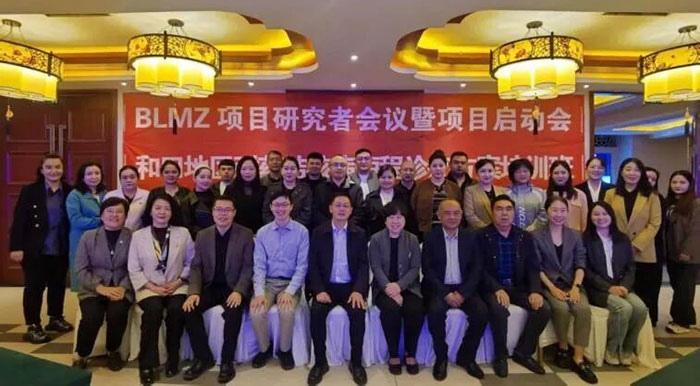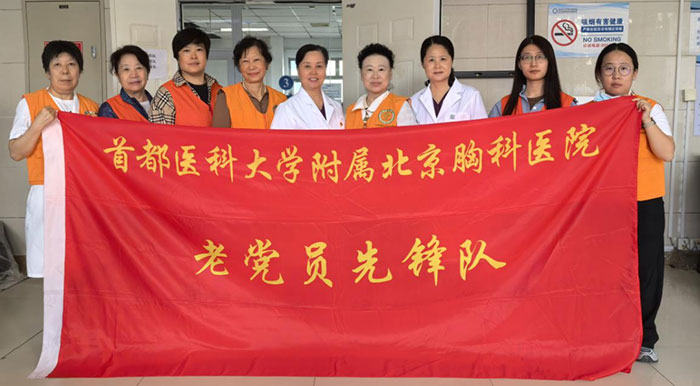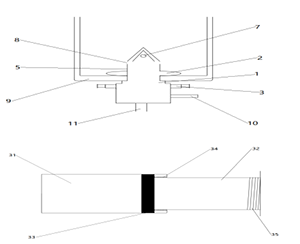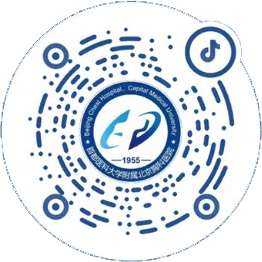2019年
No.20
Medical Abstracts
Keyword: lung cancer
1. Nature. 2019 Nov;575(7782):380-384. doi: 10.1038/s41586-019-1715-0. Epub 2019 Oct
30.
In vivo imaging of mitochondrial membrane potential in non-small-cell lung
cancer.
Momcilovic M(1), Jones A(2), Bailey ST(3), Waldmann CM(2), Li R(1), Lee
JT(2)(4)(5), Abdelhady G(1), Gomez A(6), Holloway T(2), Schmid E(7), Stout D(8),
Fishbein MC(9), Stiles L(10), Dabir DV(11), Dubinett SM(1)(2)(5)(9)(12),
Christofk H(2)(5)(7)(13), Shirihai O(5)(10), Koehler CM(6), Sadeghi S(2),
Shackelford DB(14)(15).
Author information:
(1)Division of Pulmonary and Critical Care Medicine, Department of Medicine,
David Geffen School of Medicine at the University of California, Los Angeles, CA,
USA.
。。。
Erratum in
Nature. 2020 Jan;577(7791):E7.
Comment in
Nature. 2019 Nov;575(7782):296-297.
Mitochondria are essential regulators of cellular energy and metabolism, and have
a crucial role in sustaining the growth and survival of cancer cells. A central
function of mitochondria is the synthesis of ATP by oxidative phosphorylation,
known as mitochondrial bioenergetics. Mitochondria maintain oxidative
phosphorylation by creating a membrane potential gradient that is generated by
the electron transport chain to drive the synthesis of ATP1. Mitochondria are
essential for tumour initiation and maintaining tumour cell growth in cell
culture and xenografts2,3. However, our understanding of oxidative mitochondrial
metabolism in cancer is limited because most studies have been performed in vitro
in cell culture models. This highlights a need for in vivo studies to better
understand how oxidative metabolism supports tumour growth. Here we measure
mitochondrial membrane potential in non-small-cell lung cancer in vivo using a
voltage-sensitive, positron emission tomography (PET) radiotracer known as
4-[18F]fluorobenzyl-triphenylphosphonium (18F-BnTP)4. By using PET imaging of
18F-BnTP, we profile mitochondrial membrane potential in autochthonous mouse
models of lung cancer, and find distinct functional mitochondrial heterogeneity
within subtypes of lung tumours. The use of 18F-BnTP PET imaging enabled us to
functionally profile mitochondrial membrane potential in live tumours.
DOI: 10.1038/s41586-019-1715-0
PMID: 31666695
2. Lancet. 2019 Nov 23;394(10212):1929-1939. doi: 10.1016/S0140-6736(19)32222-6.
Epub 2019 Oct 4.
Durvalumab plus platinum-etoposide versus platinum-etoposide in first-line
treatment of extensive-stage small-cell lung cancer (CASPIAN): a randomised,
controlled, open-label, phase 3 trial.
Paz-Ares L(1), Dvorkin M(2), Chen Y(3), Reinmuth N(4), Hotta K(5), Trukhin D(6),
Statsenko G(7), Hochmair MJ(8), Özgüro?lu M(9), Ji JH(10), Voitko O(11),
Poltoratskiy A(12), Ponce S(13), Verderame F(14), Havel L(15), Bondarenko I(16),
Kazarnowicz A(17), Losonczy G(18), Conev NV(19), Armstrong J(20), Byrne N(20),
Shire N(21), Jiang H(21), Goldman JW(22); CASPIAN investigators.
Author information:
(1)Department of Medical Oncology, Hospital Universitario 12 de Octubre,
H120-CNIO Lung Cancer Unit, Universidad Complutense and Ciberonc, Madrid, Spain.
Electronic address: lpazaresr@seom.org.
。。。
Comment in
Lancet. 2019 Nov 23;394(10212):1884-1885.
BACKGROUND: Most patients with small-cell lung cancer (SCLC) have extensive-stage
disease at presentation, and prognosis remains poor. Recently, immunotherapy has
demonstrated clinical activity in extensive-stage SCLC (ES-SCLC). The CASPIAN
trial assessed durvalumab, with or without tremelimumab, in combination with
etoposide plus either cisplatin or carboplatin (platinum-etoposide) in
treatment-naive patients with ES-SCLC.
METHODS: This randomised, open-label, phase 3 trial was done at 209 sites across
23 countries. Eligible patients were adults with untreated ES-SCLC, with WHO
performance status 0 or 1 and measurable disease as per Response Evaluation
Criteria in Solid Tumors, version 1.1. Patients were randomly assigned (in a
1:1:1 ratio) to durvalumab plus platinum-etoposide; durvalumab plus tremelimumab
plus platinum-etoposide; or platinum-etoposide alone. All drugs were administered
intravenously. Platinum-etoposide consisted of etoposide 80-100 mg/m2 on days 1-3
of each cycle with investigator's choice of either carboplatin area under the
curve 5-6 mg/mL per min or cisplatin 75-80 mg/m2 (administered on day 1 of each
cycle). Patients received up to four cycles of platinum-etoposide plus durvalumab
1500 mg with or without tremelimumab 75 mg every 3 weeks followed by maintenance
durvalumab 1500 mg every 4 weeks in the immunotherapy groups and up to six cycles
of platinum-etoposide every 3 weeks plus prophylactic cranial irradiation
(investigator's discretion) in the platinum-etoposide group. The primary endpoint
was overall survival in the intention-to-treat population. We report results for
the durvalumab plus platinum-etoposide group versus the platinum-etoposide group
from a planned interim analysis. Safety was assessed in all patients who received
at least one dose of their assigned study treatment. This study is registered at
ClinicalTrials.gov, NCT03043872, and is ongoing.
FINDINGS: Patients were enrolled between March 27, 2017, and May 29, 2018. 268
patients were allocated to the durvalumab plus platinum-etoposide group and 269
to the platinum-etoposide group. Durvalumab plus platinum-etoposide was
associated with a significant improvement in overall survival, with a hazard
ratio of 0·73 (95% CI 0·59-0·91; p=0·0047]); median overall survival was 13·0
months (95% CI 11·5-14·8) in the durvalumab plus platinum-etoposide group versus
10·3 months (9·3-11·2) in the platinum-etoposide group, with 34% (26·9-41·0)
versus 25% (18·4-31·6) of patients alive at 18 months. Any-cause adverse events
of grade 3 or 4 occurred in 163 (62%) of 265 treated patients in the durvalumab
plus platinum-etoposide group and 166 (62%) of 266 in the platinum-etoposide
group; adverse events leading to death occurred in 13 (5%) and 15 (6%) patients.
INTERPRETATION: First-line durvalumab plus platinum-etoposide significantly
improved overall survival in patients with ES-SCLC versus a clinically relevant
control group. Safety findings were consistent with the known safety profiles of
all drugs received.
FUNDING: AstraZeneca.
Copyright © 2019 Elsevier Ltd. All rights reserved.
DOI: 10.1016/S0140-6736(19)32222-6
PMID: 31590988 [Indexed for MEDLINE]
3. Lancet Oncol. 2019 Dec;20(12):1691-1701. doi: 10.1016/S1470-2045(19)30655-2. Epub
2019 Oct 25.
Lorlatinib in advanced ROS1-positive non-small-cell lung cancer: a multicentre,
open-label, single-arm, phase 1-2 trial.
Shaw AT(1), Solomon BJ(2), Chiari R(3), Riely GJ(4), Besse B(5), Soo RA(6), Kao
S(7), Lin CC(8), Bauer TM(9), Clancy JS(10), Thurm H(11), Martini JF(11), Peltz
G(12), Abbattista A(13), Li S(11), Ou SI(14).
Author information:
(1)Massachusetts General Hospital, Boston, MA, USA. Electronic address:
ashaw1@mgh.harvard.edu.
。。。
BACKGROUND: Lorlatinib is a potent, brain-penetrant, third-generation tyrosine
kinase inhibitor (TKI) that targets ALK and ROS1 with preclinical activity
against most known resistance mutations in ALK and ROS1. We investigated the
antitumour activity and safety of lorlatinib in advanced, ROS1-positive
non-small-cell lung cancer (NSCLC).
METHODS: In this open-label, single-arm, phase 1-2 trial, we enrolled patients
(aged ≥18 years) with histologically or cytologically confirmed advanced
ROS1-positive NSCLC, with or without CNS metastases, with an Eastern Cooperative
Oncology Group performance status of 2 or less (≤1 for phase 1 only) from 28
hospitals in 12 countries worldwide. Lorlatinib 100 mg once daily (escalating
doses of 10 mg once daily to 100 mg twice daily in phase 1 only) was given orally
in continuous 21-day cycles until investigator-determined disease progression,
unacceptable toxicity, withdrawal of consent, or death. The primary endpoint was
overall and intracranial tumour response, assessed by independent central review.
Activity endpoints were assessed in patients who received at least one dose of
lorlatinib. This study is ongoing and is registered with ClinicalTrials.gov,
NCT01970865.
FINDINGS: Between Jan 22, 2014, and Oct 2, 2016, we assessed 364 patients, of
whom 69 with ROS1-positive NSCLC were enrolled. 21 (30%) of 69 patients were
TKI-naive, 40 (58%) had previously received crizotinib as their only TKI, and
eight (12%) had previously received one non-crizotinib ROS1 TKI or two or more
ROS1 TKIs. The estimated median duration of follow-up for response was 21·1
months (IQR 15·2-30·3). 13 (62%; 95% CI 38-82) of 21 TKI-naive patients and 14
(35%; 21-52) of 40 patients previously treated with crizotinib as their only TKI
had an objective response. Intracranial responses were achieved in seven (64%;
95% CI 31-89) of 11 TKI-naive patients and 12 (50%; 29-71) of 24 previous
crizotinib-only patients. The most common grade 3-4 treatment-related adverse
events were hypertriglyceridaemia (13 [19%] of 69 patients) and
hypercholesterolaemia (ten [14%]). Serious treatment-related adverse events
occurred in five (7%) of 69 patients. No treatment-related deaths were reported.
INTERPRETATION: Lorlatinib showed clinical activity in patients with advanced
ROS1-positive NSCLC, including those with CNS metastases and those previously
treated with crizotinib. Because crizotinib-refractory patients have few
treatment options, lorlatinib could represent an important next-line targeted
agent.
FUNDING: Pfizer.
Copyright © 2019 Elsevier Ltd. All rights reserved.
DOI: 10.1016/S1470-2045(19)30655-2
PMID: 31669155
4. Lancet Oncol. 2019 Dec;20(12):1670-1680. doi: 10.1016/S1470-2045(19)30519-4. Epub
2019 Oct 7.
Patient-reported outcomes with durvalumab after chemoradiotherapy in stage III,
unresectable non-small-cell lung cancer (PACIFIC): a randomised, controlled,
phase 3 study.
Hui R(1), Özgüro?lu M(2), Villegas A(3), Daniel D(4), Vicente D(5), Murakami
S(6), Yokoi T(7), Chiappori A(8), Lee KH(9), de Wit M(10), Cho BC(11), Gray
JE(8), Rydén A(12), Viviers L(13), Poole L(14), Zhang Y(15), Dennis PA(15),
Antonia SJ(8).
Author information:
(1)Department of Medical Oncology, Westmead Hospital and the University of
Sydney, Sydney, NSW, Australia. Electronic address: rina.hui@sydney.edu.au.
。。。
BACKGROUND: In the ongoing, phase 3 PACIFIC trial, durvalumab improved the
primary endpoints of progression-free survival and overall survival compared with
that for placebo, with similar safety, in patients with unresectable, stage III
non-small-cell lung cancer. In this analysis, we aimed to evaluate one of the
secondary endpoints, patient-reported outcomes (PROs).
METHODS: PACIFIC is an ongoing, international, multicentre, double-blind,
randomised, controlled, phase 3 trial. Eligible patients were aged at least 18
years, had a WHO performance status of 0 or 1, with histologically or
cytologically documented stage III, unresectable non-small-cell lung cancer, for
which they had received at least two cycles of platinum-based chemoradiotherapy,
with no disease progression after this treatment. We randomly assigned patients
(2:1) using an interactive voice response system and a blocked design (block
size=3) stratified by age, sex, and smoking history to receive 10 mg/kg
intravenous durvalumab or matching placebo 1-42 days after concurrent
chemoradiotherapy, then every 2 weeks up to 12 months. The primary endpoints of
progression-free survival and overall survival have been reported previously.
PROs were a prespecified secondary outcome. We assessed PRO symptoms,
functioning, and global health status or quality of life in the
intention-to-treat population with the European Organisation for Research and
Treatment of Cancer (EORTC) Quality of Life Questionnaire-Core 30 (QLQ-C30)
version 3 and its lung cancer module, the Quality of Life Questionnaire-Lung
Cancer 13 (QLQ-LC13) at the time of random allocation to groups, at weeks 4 and
8, every 8 weeks until week 48, and then every 12 weeks until progression.
Changes from baseline to 12 month in key symptoms were analysed with mixed model
for repeated measures (MMRM) and time-to-event analyses. A 10-point or greater
change from baseline (deterioration or improvement) was deemed clinically
relevant. This study is registered with ClinicalTrials.gov, NCT02125461, and
EudraCT, 2014-000336-42.
FINDINGS: Between May 9, 2014, and April 22, 2016, 476 patients were assigned to
receive durvalumab, and 237 patients were assigned to receive placebo. As of
March 22, 2018, the median follow-up was 25·2 months (IQR 14·1-29·5). More than
79% of patients given durvalumab and more than 82% of patients given placebo
completed questionnaires up to week 48. Between baseline and 12 months, the
prespecified longitudinal PROs of interest, cough (MMRM-adjusted mean change 1·8
[95% CI 0·06 to 3·54] in the durvalumab group vs 0·7 [-1·91 to 3·30] in the
placebo group), dyspnoea (3·1 [1·75 to 4·36] vs 1·4 [-0·51 to 3·34]), chest pain
(-3·1 [-4·57 to -1·60] vs -3·5 [-5·68 to -1·29]), fatigue (-3·0 [-4·53 to -1·50]
vs -5·2 [-7·45 to -2·98]), appetite loss (-5·8 [-7·28 to -4·36] vs -7·0 [-9·17 to -4·87]), physical functioning (0·1 [-1·10 to 1·28] vs 2·0 [0·22 to 3·73]), and global health status or quality of life (2·6 [1·21 to 3·94] vs 1·8 [-0·25 to
3·81]) remained stable with both treatments, with no clinically relevant changes
from baseline. The between-group differences in changes from baseline to 12
months in cough (difference in adjusted mean changes 1·1, 95% CI -1·89 to 4·11),
dyspnoea (1·6, -0·58 to 3·87), chest pain (0·4, -2·13 to 2·93), fatigue (2·2,
-0·38 to 4·78), appetite loss (1·2, -1·27 to 3·67), physical functioning (-1·9,
-3·91 to 0·15), or global health status or quality of life (0·8, -1·55 to 3·14)
were not clinically relevant. Generally, there were no clinically important
between-group differences in time to deterioration of prespecified key PRO
endpoints.
INTERPRETATION: Our findings suggest that a clinical benefit with durvalumab can
be attained without compromising PROs. This result is of note because the
previous standard of care was observation alone, with no presumed detriment to
PROs.
FUNDING: AstraZeneca.
Copyright © 2019 Elsevier Ltd. All rights reserved.
DOI: 10.1016/S1470-2045(19)30519-4
PMID: 31601496
5. Nat Med. 2019 Oct;25(10):1549-1559. doi: 10.1038/s41591-019-0592-2. Epub 2019 Oct
7.
Spatial heterogeneity of the T cell receptor repertoire reflects the mutational
landscape in lung cancer.
Joshi K(1)(2), Robert de Massy M(1), Ismail M(3), Reading JL(1), Uddin I(3),
Woolston A(3), Hatipoglu E(1)(2), Oakes T(3), Rosenthal R(4)(5), Peacock T(3)(6),
Ronel T(3)。。。
Author information:
(1)Cancer Immunology Unit, Research Department of Haematology, University College
London Cancer Institute, London, UK.
(2)Department of Medical Oncology, The Royal Marsden NHS Foundation Trust,
London, UK.
。。。
Somatic mutations together with immunoediting drive extensive heterogeneity
within non-small-cell lung cancer (NSCLC). Herein we examine heterogeneity of the
T cell antigen receptor (TCR) repertoire. The number of TCR sequences selectively
expanded in tumors varies within and between tumors and correlates with the
number of nonsynonymous mutations. Expanded TCRs can be subdivided into TCRs
found in all tumor regions (ubiquitous) and those present in a subset of regions
(regional). The number of ubiquitous and regional TCRs correlates with the number
of ubiquitous and regional nonsynonymous mutations, respectively. Expanded TCRs
form part of clusters of TCRs of similar sequence, suggestive of a spatially
constrained antigen-driven process. CD8+ tumor-infiltrating lymphocytes harboring
ubiquitous TCRs display a dysfunctional tissue-resident phenotype. Ubiquitous
TCRs are preferentially detected in the blood at the time of tumor resection as
compared to routine follow-up. These findings highlight a noninvasive method to
identify and track relevant tumor-reactive TCRs for use in adoptive T cell
immunotherapy.
DOI: 10.1038/s41591-019-0592-2
PMCID: PMC6890490 [Available on 2020-04-01]
PMID: 31591606 [Indexed for MEDLINE]
6. Nat Med. 2019 Oct;25(10):1540-1548. doi: 10.1038/s41591-019-0595-z. Epub 2019 Oct
7.
A clonal expression biomarker associates with lung cancer mortality.
Biswas D(1)(2)(3), Birkbak NJ(4)(5)(6)(7), Rosenthal R(1)(2)(3), Hiley CT(1)(3),
Lim EL(1)(3),。。。
Author information:
(1)Cancer Research UK Lung Cancer Centre of Excellence, University College London
Cancer Institute, Paul O'Gorman Building, London, UK.
。。。
An aim of molecular biomarkers is to stratify patients with cancer into disease
subtypes predictive of outcome, improving diagnostic precision beyond clinical
descriptors such as tumor stage1. Transcriptomic intratumor heterogeneity
(RNA-ITH) has been shown to confound existing expression-based biomarkers across
multiple cancer types2-6. Here, we analyze multi-region whole-exome and RNA
sequencing data for 156 tumor regions from 48 patients enrolled in the TRACERx
study to explore and control for RNA-ITH in non-small cell lung cancer. We find
that chromosomal instability is a major driver of RNA-ITH, and existing
prognostic gene expression signatures are vulnerable to tumor sampling bias. To
address this, we identify genes expressed homogeneously within individual tumors
that encode expression modules of cancer cell proliferation and are often driven
by DNA copy-number gains selected early in tumor evolution. Clonal transcriptomic
biomarkers overcome tumor sampling bias, associate with survival independent of
clinicopathological risk factors, and may provide a general strategy to refine
biomarker design across cancer types.
DOI: 10.1038/s41591-019-0595-z
PMCID: PMC6984959 [Available on 2020-04-01]
PMID: 31591602 [Indexed for MEDLINE]
7. Lancet Oncol. 2019 Dec;20(12):1655-1669. doi: 10.1016/S1470-2045(19)30634-5. Epub
2019 Oct 4.
Ramucirumab plus erlotinib in patients with untreated, EGFR-mutated, advanced
non-small-cell lung cancer (RELAY): a randomised, double-blind,
placebo-controlled, phase 3 trial.
Nakagawa K(1), Garon EB(2), Seto T(3), Nishio M(4), Ponce Aix S(5), 。。。
Author information:
(1)Department of Medical Oncology, Kindai University Faculty of Medicine, Osaka,
Japan. Electronic address: nakagawa@med.kindai.ac.jp.
。。。
BACKGROUND: Dual blockade of the EGFR and VEGF pathways in EGFR-mutated
metastatic non-small-cell lung cancer (NSCLC) is supported by preclinical and
clinical data, yet the approach is not widely implemented. RELAY assessed
erlotinib, an EGFR tyrosine kinase inhibitor (TKI) standard of care, plus
ramucirumab, a human IgG1 VEGFR2 antagonist, or placebo in patients with
untreated EGFR-mutated metastatic NSCLC.
METHODS: This is a worldwide, double-blind, phase 3 trial done in 100 hospitals,
clinics, and medical centres in 13 countries. Eligible patients were aged 18
years or older (20 years or older in Japan and Taiwan) at the time of study
entry, had stage IV NSCLC, with an EGFR exon 19 deletion (ex19del) or exon 21
substitution (Leu858Arg) mutation, an Eastern Cooperative Oncology Group
performance status of 0 or 1, and no CNS metastases. We randomly assigned
eligible patients in a 1:1 ratio to receive oral erlotinib (150 mg/day) plus
either intravenous ramucirumab (10 mg/kg) or matching placebo once every 2 weeks.
Randomisation was done by an interactive web response system with a
computer-generated sequence and stratified by sex, geographical region, EGFR
mutation type, and EGFR testing method. The primary endpoint was
investigator-assessed progression-free survival in the intention-to-treat
population. Safety was assessed in all patients who received at least one dose of
study treatment. This trial is registered at ClinicalTrials.gov, NCT02411448, and
is ongoing for long-term survival follow-up.
FINDINGS: Between Jan 28, 2016, and Feb 1, 2018, 449 eligible patients were
enrolled and randomly assigned to treatment with ramucirumab plus erlotinib
(n=224) or placebo plus erlotinib (n=225). Median duration of follow-up was 20·7
months (IQR 15·8-27·2). At the time of primary analysis, progression-free
survival was significantly longer in the ramucirumab plus erlotinib group (19·4
months [95% CI 15·4-21·6]) than in the placebo plus erlotinib group (12·4 months
[11·0-13·5]), with a stratified hazard ratio of 0·59 (95% CI 0·46-0·76;
p<0·0001). Grade 3-4 treatment-emergent adverse events were reported in 159 (72%)
of 221 patients in the ramucirumab plus erlotinib group versus 121 (54%) of 225
in the placebo plus erlotinib group. The most common grade 3-4 treatment-emergent
adverse events in the ramucirumab plus erlotinib group were hypertension (52
[24%]; grade 3 only) and dermatitis acneiform (33 [15%]), and in the placebo plus
erlotinib group were dermatitis acneiform (20 [9%]) and increased alanine
aminotransferase (17 [8%]). Treatment-emergent serious adverse events were
reported in 65 (29%) of 221 patients in the ramucirumab plus erlotinib group and
47 (21%) of 225 in the placebo plus erlotinib group. The most common serious
adverse events of any grade in the ramucirumab plus erlotinib group were
pneumonia (seven [3%]) and cellulitis and pneumothorax (four [2%], each); the
most common in the placebo plus erlotinib group were pyrexia (four [2%]) and
pneumothorax (three [1%]). One on-study treatment-related death due to an adverse
event occurred (haemothorax after a thoracic drainage procedure for a pleural
empyema) in the ramucirumab plus erlotinib group.
INTERPRETATION: Ramucirumab plus erlotinib demonstrated superior progression-free
survival compared with placebo plus erlotinib in patients with untreated
EGFR-mutated metastatic NSCLC. Safety was consistent with the safety profiles of
the individual compounds in advanced lung cancer. The RELAY regimen is a viable
new treatment option for the initial treatment of EGFR-mutated metastatic NSCLC.
FUNDING: Eli Lilly.
Copyright © 2019 Elsevier Ltd. All rights reserved.
DOI: 10.1016/S1470-2045(19)30634-5
PMID: 31591063
8. Lancet Oncol. 2019 Dec;20(12):1681-1690. doi: 10.1016/S1470-2045(19)30504-2. Epub
2019 Oct 3.
Lazertinib in patients with EGFR mutation-positive advanced non-small-cell lung
cancer: results from the dose escalation and dose expansion parts of a
first-in-human, open-label, multicentre, phase 1-2 study.
Ahn MJ(1), Han JY(2), Lee KH(3), Kim SW(4), Kim DW(5), Lee YG(6), Cho EK(7), Kim
JH(8), Lee GW(9), Lee JS(10), Min YJ(11), Kim JS(12), Lee SS(13), Kim HR(14),
Hong MH(14), Ahn JS(1), Sun JM(1), Kim HT(2), Lee DH(4), Kim S(15), Cho BC(16).
Author information:
(1)Division of Hematology-Oncology, Department of Medicine, Samsung Medical
Center, Sungkyunkwan University School of Medicine, Seoul, South Korea.
。。。
Erratum in
Lancet Oncol. 2020 Feb;21(2):e70.
BACKGROUND: Patients with EGFR-mutated non-small-cell lung cancer (NSCLC) given
EGFR tyrosine kinase inhibitors (TKIs) inevitably become resistant to
first-generation or second-generation drugs. We assessed the safety,
tolerability, pharmacokinetics, and activity of lazertinib-an irreversible,
third-generation, mutant-selective, EGFR TKI-in patients with advanced NSCLC
progressing after EGFR TKI therapy.
METHODS: This first-in-human, open-label, multicentre, phase 1-2 study had three
parts: dose escalation, dose expansion, and dose extension; here, we report
results on dose escalation and dose expansion. The study was done in 14 hospitals
in Korea. Eligible patients were aged 20 years or older and had advanced NSCLC
harbouring an activating EGFR mutation and progressing after first-generation or
second-generation EGFR TKI treatment, a defined tumour T790M mutation status, an
Eastern Cooperative Oncology Group performance status of 0-1, at least one
measurable extracranial lesion, defined according to Response Evaluation Criteria
in Solid Tumors (RECIST) version 1.1, and adequate organ function. Patients were
enrolled to seven dose-escalation cohorts according to a rolling six design; five
cohorts were expanded. Patients were given oral lazertinib 20 mg, 40 mg, 80 mg,
120 mg, 160 mg, 240 mg, or 320 mg once daily continuously in 21-day cycles.
Primary endpoints were safety and tolerability and secondary endpoints included
objective response in evaluable patients. This study is registered with
ClinicalTrials.gov, NCT03046992, and the phase 2 extension study is ongoing.
FINDINGS: Between Feb 15, 2017, and May 28, 2018, 127 patients were enrolled into
the dose escalation group (n=38) and dose expansion group (n=89). No
dose-limiting toxicities occurred. There was no dose-dependent increase in
adverse events. The most commonly reported adverse events were grade 1-2 rash or
acne (in 38 [30%] of 127 patients) and pruritus (in 34 [27%]). Grade 3 or grade 4
adverse events occurred in 20 (16%) patients, with the most common being grade 3
pneumonia (four [3%]). Treatment-related grade 3 or 4 adverse events occurred in
four (3%) patients; treatment-related serious adverse events were reported in six
patients (5%). There were no adverse events with an outcome of death and no
treatment-related deaths. The proportion of patients achieving an objective
response by independent central review assessment was 69 (54%; 95% CI 46-63) of
127.
INTERPRETATION: Lazertinib had a tolerable safety profile and showed promosing
clinical activity in patients with NSCLC progressing on or after EGFR TKI
therapy. Our findings provide a rationale for further clinical investigations.
FUNDING: Yuhan Corporation.
Copyright © 2019 Elsevier Ltd. All rights reserved.
DOI: 10.1016/S1470-2045(19)30504-2
PMID: 31587882
9. Lancet Oncol. 2019 Oct;20(10):e582-e589. doi: 10.1016/S1470-2045(19)30335-3. Epub
2019 Sep 30.
US Food and Drug Administration review of statistical analysis of
patient-reported outcomes in lung cancer clinical trials approved between
January, 2008, and December, 2017.
Fiero MH(1), Roydhouse JK(2), Vallejo J(3), King-Kallimanis BL(2), Kluetz PG(4),
Sridhara R(3).
Author information:
(1)Office of Biostatistics, Center for Drug Evaluation and Research, US Food and
Drug Administration, Silver Spring, MD, USA. Electronic address:
mallorie.fiero@fda.hhs.gov.
(2)Office of Hematology and Oncology Products, Center for Drug Evaluation and
Research, US Food and Drug Administration, Silver Spring, MD, USA.
(3)Office of Biostatistics, Center for Drug Evaluation and Research, US Food and
Drug Administration, Silver Spring, MD, USA.
(4)Oncology Center of Excellence, US Food and Drug Administration, Silver Spring,
MD, USA.
With the advent of patient-focused drug development, the US Food and Drug
Administration (FDA) has redoubled its efforts to review patient-reported outcome
(PRO) data in cancer trials submitted as part of a drug's marketing application.
This Review aims to characterise the statistical analysis of PRO data from
pivotal lung cancer trials submitted to support FDA drug approval between
January, 2008, and December, 2017. For each trial and PRO instrument identified,
we evaluated prespecified PRO concepts, statistical analysis, missing data and
sensitivity analysis, instrument completion, and clinical relevance. Of the 37
pivotal lung cancer trials used to support FDA drug approval, 25 (68%) trials
included PRO measures. The most common prespecified PRO concepts were cough,
dyspnoea, and chest pain. At the trial level, the most common statistical
analyses were descriptive (24 trials [96%]), followed by time-to-event analyses
(19 trials [76%]), longitudinal analyses (12 trials [48%]), and basic inferential
tests or general linear models (10 trials [40%]). Our findings indicate a wide
variation in the analytic techniques and data presentation methods used, with
very few trials reporting clear PRO research objectives and sensitivity analyses
for PRO results. Our work further supports the need for focused research
objectives to justify and to guide the analytic strategy of PROs to facilitate
the interpretation of patient experience.
Copyright © 2019 Elsevier Ltd. All rights reserved.
DOI: 10.1016/S1470-2045(19)30335-3
PMID: 31579004
10. Lancet Oncol. 2019 Oct;20(10):1395-1408. doi: 10.1016/S1470-2045(19)30407-3. Epub
2019 Aug 14.
Four-year survival with nivolumab in patients with previously treated advanced
non-small-cell lung cancer: a pooled analysis.
Antonia SJ(1), Borghaei H(2), Ramalingam SS(3), Horn L(4), De Castro Carpeño
J(5), Pluzanski A(6), Burgio MA(7), Garassino M(8), Chow LQM(9), Gettinger S(10),
Crinò L(7), Planchard D(11), Butts C(12), Drilon A(13), Wojcik-Tomaszewska J(14),
Otterson GA(15), Agrawal S(16), Li A(16), Penrod JR(16), Brahmer J(17).
Author information:
(1)H Lee Moffitt Cancer Center & Research Institute, Tampa, FL, USA. Electronic
address: scott.antonia@duke.edu.
。。。
BACKGROUND: Phase 3 clinical data has shown higher proportions of patients with
objective response, longer response duration, and longer overall survival with
nivolumab versus docetaxel in patients with previously treated advanced
non-small-cell lung cancer (NSCLC). We aimed to evaluate the long-term benefit of
nivolumab and the effect of response and disease control on subsequent survival.
METHODS: We pooled data from four clinical studies of nivolumab in patients with
previously treated NSCLC (CheckMate 017, 057, 063, and 003) to evaluate survival
outcomes. Trials of nivolumab in the second-line or later setting with at least 4
years follow-up were included. Comparisons of nivolumab versus docetaxel included
all randomised patients from the phase 3 CheckMate 017 and 057 studies. We did
landmark analyses by response status at 6 months to determine post-landmark
survival outcomes. We excluded patients who did not have a radiographic tumour
assessment at 6 months. Safety analyses included all patients who received at
least one dose of nivolumab.
FINDINGS: Across all four studies, 4-year overall survival with nivolumab was 14%
(95% CI 11-17) for all patients (n=664), 19% (15-24) for those with at least 1%
PD-L1 expression, and 11% (7-16) for those with less than 1% PD-L1 expression. In
CheckMate 017 and 057, 4-year overall survival was 14% (95% CI 11-18) in patients
treated with nivolumab, compared with 5% (3-7) in patients treated with
docetaxel. Survival subsequent to response at 6 months on nivolumab or docetaxel
was longer than after progressive disease at 6 months, with hazard ratios for
overall survival of 0·18 (95% 0·12-0·27) for nivolumab and 0·43 (0·29-0·65) for
docetaxel; for stable disease versus progressive disease, hazard ratios were 0·52
(0·37-0·71) for nivolumab and 0·80 (0·61-1·04) for docetaxel. Long-term data did
not show any new safety signals.
INTERPRETATION: Patients with advanced NSCLC treated with nivolumab achieved a
greater duration of response compared with patients treated with docetaxel, which
was associated with a long-term survival advantage.
FUNDING: Bristol-Myers Squibb.
Copyright © 2019 Elsevier Ltd. All rights reserved.
DOI: 10.1016/S1470-2045(19)30407-3
PMID: 31422028
11. Nat Commun. 2019 Oct 25;10(1):4892. doi: 10.1038/s41467-019-12801-6.
YTHDF1 links hypoxia adaptation and non-small cell lung cancer progression.
Shi Y(1)(2), Fan S(3), Wu M(4), Zuo Z(5), Li X(5), Jiang L(1), Shen Q(1)(2), Xu
P(1), Zeng L(1)(2), Zhou Y(4), Huang Y(4), Yang Z(4), Zhou J(1), Gao J(6), Zhou
H(6), Xu S(7)(8), Ji H(9), Shi P(8)(10), Wu DD(11)(12), Yang C(13), Chen
Y(14)(15).
Author information:
(1)Key Laboratory of Animal Models and Human Disease Mechanisms of Chinese
Academy of Sciences & Yunnan Province, Kunming Institute of Zoology, Kunming,
Yunnan, 650223, China.
。。。
Hypoxia occurs naturally at high-altitudes and pathologically in hypoxic solid
tumors. Here, we report that genes involved in various human cancers evolved
rapidly in Tibetans and six Tibetan domestic mammals compared to reciprocal
lowlanders. Furthermore, m6A modified mRNA binding protein YTHDF1, one of
evolutionary positively selected genes for high-altitude adaptation is amplified
in various cancers, including non-small cell lung cancer (NSCLC). We show that
YTHDF1 deficiency inhibits NSCLC cell proliferation and xenograft tumor formation
through regulating the translational efficiency of CDK2, CDK4, and cyclin D1, and
that YTHDF1 depletion restrains de novo lung adenocarcinomas (ADC) progression.
However, we observe that YTHDF1 high expression correlates with better clinical
outcome, with its depletion rendering cancerous cells resistant to cisplatin
(DDP) treatment. Mechanistic studies identified the Keap1-Nrf2-AKR1C1 axis as the
downstream mediator of YTHDF1. Together, these findings highlight the critical
role of YTHDF1 in both hypoxia adaptation and pathogenesis of NSCLC.
DOI: 10.1038/s41467-019-12801-6
PMCID: PMC6814821
PMID: 31653849
12. Ann Intern Med. 2019 Oct 22. doi: 10.7326/M19-1263. [Epub ahead of print]
Life-Gained-Based Versus Risk-Based Selection of Smokers for Lung Cancer
Screening.
Cheung LC(1), Berg CD(1), Castle PE(2), Katki HA(1), Chaturvedi AK(1).
Author information:
(1)National Cancer Institute, Bethesda, Maryland (L.C.C., C.D.B., H.A.K.,
A.K.C.).
(2)Albert Einstein School of Medicine, Bronx, New York (P.E.C.).
Background: Although risk-based selection of ever-smokers for screening could
prevent more lung cancer deaths than screening according to the U.S. Preventive
Services Task Force (USPSTF) guidelines, it preferentially selects older
ever-smokers with shorter life expectancies due to comorbidities.
Objective: To compare selection of ever-smokers for screening based on gains in
life expectancy versus lung cancer risk.
Design: Cohort analyses and model-based projections.
Setting: U.S. population of ever-smokers aged 40 to 84 years.
Participants: 130 964 National Health Interview Survey participants, representing
about 60 million U.S. ever-smokers during 1997 to 2015.
Intervention: Annual computed tomography (CT) screening for 3 years versus no
screening.
Measurements: Estimated number of lung cancer deaths averted and life-years
gained after development of a mortality model.
Results: Using the calibrated and validated mortality model in U.S. ever-smokers
aged 40 to 84 years and selecting 8.3 million ever-smokers to match the number
selected by the USPSTF criteria in 2013 to 2015, the analysis estimated that
life-gained-based selection would increase the total life expectancy from CT
screening (633 400 vs. 607 800 years) but prevent fewer lung cancer deaths
(52 600 vs. 55 000) compared with risk-based selection. The 1.56 million persons
selected by the life-gained-based strategy but not the risk-based strategy were
younger (mean age, 59 vs. 75 years) and had fewer comorbidities (mean, 0.75 vs.
3.7).
Limitation: Estimates are model-based and assume implementation of lung cancer
screening with short-term effectiveness similar to that from trials.
Conclusion: Life-gained-based selection could maximize the benefits of lung
cancer screening in the U.S. population by including ever-smokers who have both
high lung cancer risk and long life expectancy.
Primary Funding Source: Intramural Research Program of the National Cancer
Institute, National Institutes of Health.
DOI: 10.7326/M19-1263
PMID: 31634914
13. Cell Metab. 2019 Dec 3;30(6):1107-1119.e8. doi: 10.1016/j.cmet.2019.09.014. Epub
2019 Oct 10.
A Novel Allosteric Inhibitor of Phosphoglycerate Mutase 1 Suppresses Growth and
Metastasis of Non-Small-Cell Lung Cancer.
Huang K(1), Liang Q(2), Zhou Y(2), Jiang LL(1), Gu WM(2), Luo MY(2), Tang YB(2),
Wang Y(2), Lu W(3), Huang M(4), Zhang SZ(5), Zhuang GL(5), Dai Q(6), Shen QC(7),
Zhang J(7), Lei HM(2), Zhu L(2), Ye DY(1), Chen HZ(8), Zhou L(9), Shen Y(10).
Author information:
(1)Department of Medicinal Chemistry, School of Pharmacy, Fudan University,
Shanghai 201203, China.
。。。
Phosphoglycerate mutase 1 (PGAM1) plays a pivotal role in cancer metabolism and
tumor progression via its metabolic activity and interaction with other proteins
like α-smooth muscle actin (ACTA2). Allosteric regulation is considered to be an
innovative strategy to discover a highly selective and potent inhibitor targeting
PGAM1. Here, we identified a novel PGAM1 allosteric inhibitor, HKB99, via
structure-based optimization. HKB99 acted to allosterically block conformational
change of PGAM1 during catalytic process and PGAM1-ACTA2 interaction. HKB99
suppressed tumor growth and metastasis and overcame erlotinib resistance in
non-small-cell lung cancer (NSCLC). Mechanistically, HKB99 enhanced the oxidative
stress and altered multiple signaling pathways including the activation of
JNK/c-Jun and suppression of AKT and ERK. Collectively, the study highlights the
potential of PGAM1 as a therapeutic target in NSCLC and reveals a distinct
mechanism by which HKB99 inhibits both metabolic activity and nonmetabolic
function of PGAM1 by allosteric regulation.
Copyright © 2019 Elsevier Inc. All rights reserved.
DOI: 10.1016/j.cmet.2019.09.014
PMID: 31607564
14. Cancer Discov. 2019 Oct;9(10):1340-1342. doi: 10.1158/2159-8290.CD-19-0850.
Temozolomide plus PARP Inhibition in Small-Cell Lung Cancer: Could
Patient-Derived Xenografts Accelerate Discovery of Biomarker Candidates?
Pacheco JM(1), Byers LA(2).
Author information:
(1)Department of Internal Medicine, Division of Medical Oncology, University of
Colorado Anschutz Cancer Center, Aurora, Colorado. jose.m.pacheco@cuanschutz.edu.
(2)Department of Thoracic/Head and Neck Medical Oncology, The University of Texas
MD Anderson Cancer Center, Houston, Texas.
Comment on
Cancer Discov. 2019 Aug 15;:.
Effective options are limited for patients with small-cell lung cancer who
develop progressive disease during or after etoposide plus platinum-based
therapy. In this issue of Cancer Discovery, Farago and colleagues highlight the
data for temozolomide plus olaparib in this patient population and demonstrate
the potential to accelerate biomarker discovery through co-clinical trials
utilizing patient-derived xenografts.See related article by Farago et al., p.
1372.
©2019 American Association for Cancer Research.
DOI: 10.1158/2159-8290.CD-19-0850
PMID: 31575562 [Indexed for MEDLINE]
15. Cancer Discov. 2019 Oct;9(10):1372-1387. doi: 10.1158/2159-8290.CD-19-0582. Epub
2019 Aug 15.
Combination Olaparib and Temozolomide in Relapsed Small-Cell Lung Cancer.
Farago AF(1)(2), Yeap BY(3)(2), Stanzione M(3), Hung YP(3)(2), Heist RS(3)(2),
Marcoux JP(2)(4), Zhong J(3), Rangachari D(2)(5), Barbie DA(2)(4), Phat S(3),
Myers DT(3), Morris R(3), Kem M(3), Dubash TD(3), Kennedy EA(3), Digumarthy
SR(2)(6), Sequist LV(3)(2), Hata AN(3)(2), Maheswaran S(3)(2), Haber DA(3)(2)(7),
Lawrence MS(3)(2), Shaw AT(3)(2), Mino-Kenudson M(3)(2), Dyson NJ(3)(2), Drapkin
BJ(1)(2).
Author information:
(1)Massachusetts General Hospital Cancer Center, Boston, Massachusetts.
afarago@mgh.harvard.edu bjdrapkin@partners.org.
(2)Dana-Farber Cancer Center, Boston, Massachusetts.
(3)Massachusetts General Hospital Cancer Center, Boston, Massachusetts.
(4)Beth Israel Deaconess Medical Center, Boston, Massachusetts.
(5)Department of Radiology, Massachusetts General Hospital, Boston,
Massachusetts.
(6)Howard Hughes Medical Institute, Bethesda, Maryland.
(7)Harvard Medical School, Boston, Massachusetts.
Comment in
Cancer Discov. 2019 Oct;9(10):1340-1342.
Small-cell lung cancer (SCLC) is an aggressive malignancy in which inhibitors of
PARP have modest single-agent activity. We performed a phase I/II trial of
combination olaparib tablets and temozolomide (OT) in patients with previously
treated SCLC. We established a recommended phase II dose of olaparib 200 mg
orally twice daily with temozolomide 75 mg/m2 daily, both on days 1 to 7 of a
21-day cycle, and expanded to a total of 50 patients. The confirmed overall
response rate was 41.7% (20/48 evaluable); median progression-free survival was
4.2 months [95% confidence interval (CI), 2.8-5.7]; and median overall survival
was 8.5 months (95% CI, 5.1-11.3). Patient-derived xenografts (PDX) from trial
patients recapitulated clinical OT responses, enabling a 32-PDX coclinical trial.
This revealed a correlation between low basal expression of inflammatory-response
genes and cross-resistance to both OT and standard first-line chemotherapy
(etoposide/platinum). These results demonstrate a promising new therapeutic
strategy in SCLC and uncover a molecular signature of those tumors most likely to
respond. SIGNIFICANCE: We demonstrate substantial clinical activity of
combination olaparib/temozolomide in relapsed SCLC, revealing a promising new
therapeutic strategy for this highly recalcitrant malignancy. Through an
integrated coclinical trial in PDXs, we then identify a molecular signature
predictive of response to OT, and describe the common molecular features of
cross-resistant SCLC.See related commentary by Pacheco and Byers, p. 1340.This
article is highlighted in the In This Issue feature, p. 1325.
©2019 American Association for Cancer Research.
DOI: 10.1158/2159-8290.CD-19-0582
PMID: 31416802
16. Am J Respir Crit Care Med. 2019 Oct 1;200(7):888-899. doi:
10.1164/rccm.201807-1292OC.
YES1 Drives Lung Cancer Growth and Progression and Predicts Sensitivity to
Dasatinib.
Garmendia I(1)(2), Pajares MJ(1)(2)(3)(4), Hermida-Prado F(3)(5), Ajona
D(1)(6)(3)(4), Bértolo C(1)(3), Sainz C(1), Lavín A(1), Remírez AB(1), 。。。
Author information:
(1)Program in Solid Tumors, Center for Applied Medical Research, Pamplona, Spain.
。。。
Comment in
Am J Respir Crit Care Med. 2019 Oct 1;200(7):802-804.
Rationale: The characterization of new genetic alterations is essential to assign
effective personalized therapies in non-small cell lung cancer (NSCLC).
Furthermore, finding stratification biomarkers is essential for successful
personalized therapies. Molecular alterations of YES1, a member of the SRC
(proto-oncogene tyrosine-protein kinase Src) family kinases (SFKs), can be found
in a significant subset of patients with lung cancer.Objectives: To evaluate YES1
(v-YES-1 Yamaguchi sarcoma viral oncogene homolog 1) genetic alteration as a
therapeutic target and predictive biomarker of response to dasatinib in
NSCLC.Methods: Functional significance was evaluated by in vivo models of NSCLC
and metastasis and patient-derived xenografts. The efficacy of pharmacological
and genetic (CRISPR [clustered regularly interspaced short palindromic
repeats]/Cas9 [CRISPR-associated protein 9]) YES1 abrogation was also evaluated.
In vitro functional assays for signaling, survival, and invasion were also
performed. The association between YES1 alterations and prognosis was evaluated
in clinical samples.Measurements and Main Results: We demonstrated that YES1 is
essential for NSCLC carcinogenesis. Furthermore, YES1 overexpression induced
metastatic spread in preclinical in vivo models. YES1 genetic depletion by
CRISPR/Cas9 technology significantly reduced tumor growth and metastasis. YES1
effects were mainly driven by mTOR (mammalian target of rapamycin) signaling.
Interestingly, cell lines and patient-derived xenograft models with YES1 gene
amplifications presented a high sensitivity to dasatinib, an SFK inhibitor,
pointing out YES1 status as a stratification biomarker for dasatinib response.
Moreover, high YES1 protein expression was an independent predictor for poor
prognosis in patients with lung cancer.Conclusions: YES1 is a promising
therapeutic target in lung cancer. Our results provide support for the clinical
evaluation of dasatinib treatment in a selected subset of patients using YES1
status as predictive biomarker for therapy.
DOI: 10.1164/rccm.201807-1292OC
PMID: 31166114









.jpg)
















